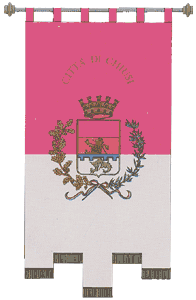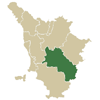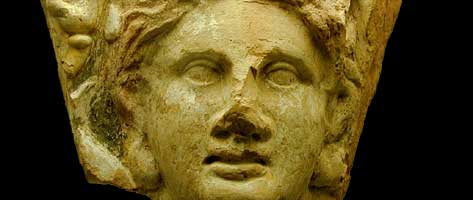|  Inhabitants in 1991: 9.103
Inhabitants in 1991: 9.103
 The
municipal territory of Chiusi extends for 58,06 square kilometres between
the plain and the hilly rises which close the south of the Val di Chiana.
Etruscan city, then Roman, capital of the Duchy and successively the
county, it reached its present day aspect in XVII century with the Leopoldina
reforms. The origin and the development of Chiusi in the Etruscan
era are testified to by numerous finds: between the VII and V centuries
B.C. it was the most powerful among the twelve cities which formed
the League of Central Italy and the most famous for the legendary exploits
of its King Posenna. At the end of the IV century B.C. it allied with
Rome becoming a municipality and then a colony under Silla (1 century
B.C.); Episcopal Seat already from IV century, around 540 it suffered
the invasion of the Goths and the conquest on the part of Totila.
Centre of an important Longobardo frontier Duchy, which was extinguished
in 776, Chiusi became county capital after the Franca conquest and from
these management classes came the origin of the principle noble lineages
which governed many of the centres among Toscana, Umbria and Lazio after
the year one thousand. Nevertheless, right in the period of the municipal
development, they did not know how to maintain this position of political
prominence (partly caused by the malaria which infested its territory
in the XI century) and it assumed a subordinate role influenced by the
larger communities: already in the second half of the XII century it made
an act of submission to Orvieto, from whom Siena tried, in vain
for all the XIII century, to remove it. After a brief period of dominion
by Perugia (1332), Chiusi took advantage of the crisis by then in act
in the Orvieto government, and rebelled in 1337, beginning to support
itself as free municipality; but in the middle of the century they were
forced to enter under the jurisdiction of Siena, whose dominion,
even though contested by Firenze, Perugia and Montepulciano, lasted until
the war of 1554, during which in the Chiusi area there was the victorious
ambush of the army of Ascanio della Cornia, general of Cosimo I dei Medici
by Siena. In 1556 Chiusi became part of the Mediceo State. The
municipal territory of Chiusi extends for 58,06 square kilometres between
the plain and the hilly rises which close the south of the Val di Chiana.
Etruscan city, then Roman, capital of the Duchy and successively the
county, it reached its present day aspect in XVII century with the Leopoldina
reforms. The origin and the development of Chiusi in the Etruscan
era are testified to by numerous finds: between the VII and V centuries
B.C. it was the most powerful among the twelve cities which formed
the League of Central Italy and the most famous for the legendary exploits
of its King Posenna. At the end of the IV century B.C. it allied with
Rome becoming a municipality and then a colony under Silla (1 century
B.C.); Episcopal Seat already from IV century, around 540 it suffered
the invasion of the Goths and the conquest on the part of Totila.
Centre of an important Longobardo frontier Duchy, which was extinguished
in 776, Chiusi became county capital after the Franca conquest and from
these management classes came the origin of the principle noble lineages
which governed many of the centres among Toscana, Umbria and Lazio after
the year one thousand. Nevertheless, right in the period of the municipal
development, they did not know how to maintain this position of political
prominence (partly caused by the malaria which infested its territory
in the XI century) and it assumed a subordinate role influenced by the
larger communities: already in the second half of the XII century it made
an act of submission to Orvieto, from whom Siena tried, in vain
for all the XIII century, to remove it. After a brief period of dominion
by Perugia (1332), Chiusi took advantage of the crisis by then in act
in the Orvieto government, and rebelled in 1337, beginning to support
itself as free municipality; but in the middle of the century they were
forced to enter under the jurisdiction of Siena, whose dominion,
even though contested by Firenze, Perugia and Montepulciano, lasted until
the war of 1554, during which in the Chiusi area there was the victorious
ambush of the army of Ascanio della Cornia, general of Cosimo I dei Medici
by Siena. In 1556 Chiusi became part of the Mediceo State.
 The town of Chiusi is situated in the hilly area in the south
of the Val di Chiana and has the oldest origins of all the settlements
in the valley; recent finds indicate there was settlement here in the
Bronze Age. Because of its history, there are lots of sites
of archaeological interest both inside and outside the town.
Places to visit:
National Archaeological Museum, instituted in 1870 comprises
a notable collection of important Etruscan, Greek and Roman finds
coming from the excavations in the territory surrounding Chiusi. The
museum comprises also Etruscan Tombs located in the Chiusi countryside
of which there are organised guided tours.
Porsenna Maze, fascinating underground route which twists for
120 metres under the historic centre of Chiusi.
Cathedral Museum, organised in the Episcopal complex adjacent
to the Cathedral, it preserves works and furnishings from the catacombs
and a collection of precious illuminated codes from the Abbey of Monte
Oliveto Maggiore.
Cathedral, named for S. Secondiano, it was founded in the VI
century and radically restored in the 1800s. Remains of a preceding
building (IV century) have been found under the present day establishment.
The 1200 Tower of S. Secondiano functions as bell tower; from its
summit a 360° view of the surrounding territory can be enjoyed.
The interior of the Cathedral is rich with works of various eras and
from various sources.
The Lago di Chiusi is over 3km long by 2km wide, and its banks
are covered by marsh grasses and populated by various species of migratory
birds which come here to nest. Besides being equipped for water sports,
it is also an ideal fishing spot. |
Historical info reproduced upon authorization of Regione Toscana - Dipartimento della Presidenza E Affari Legislativi e Giuridici
Translated by Ann Mountford |